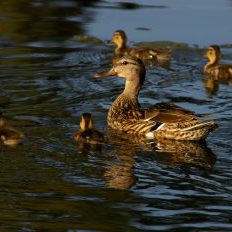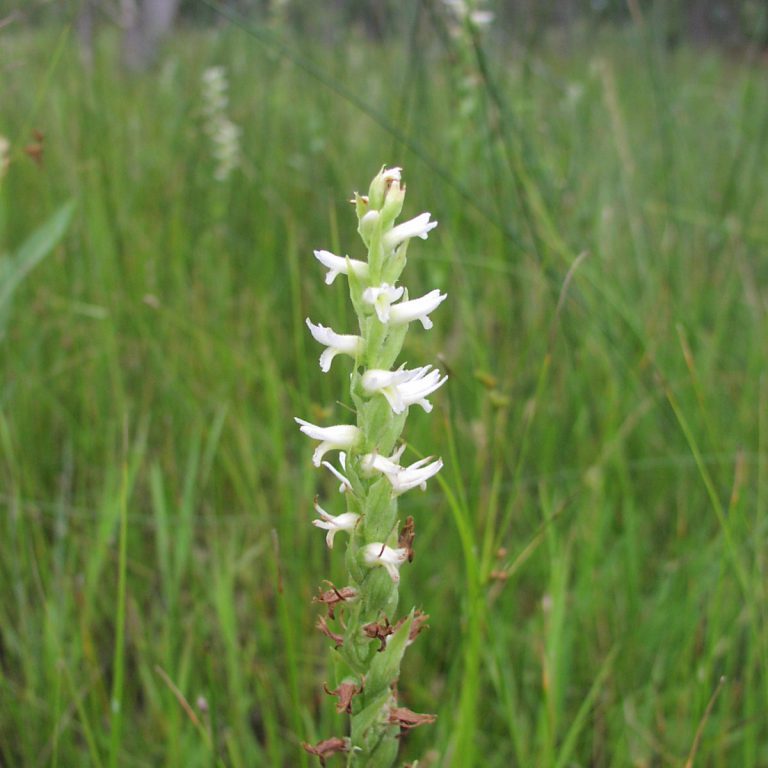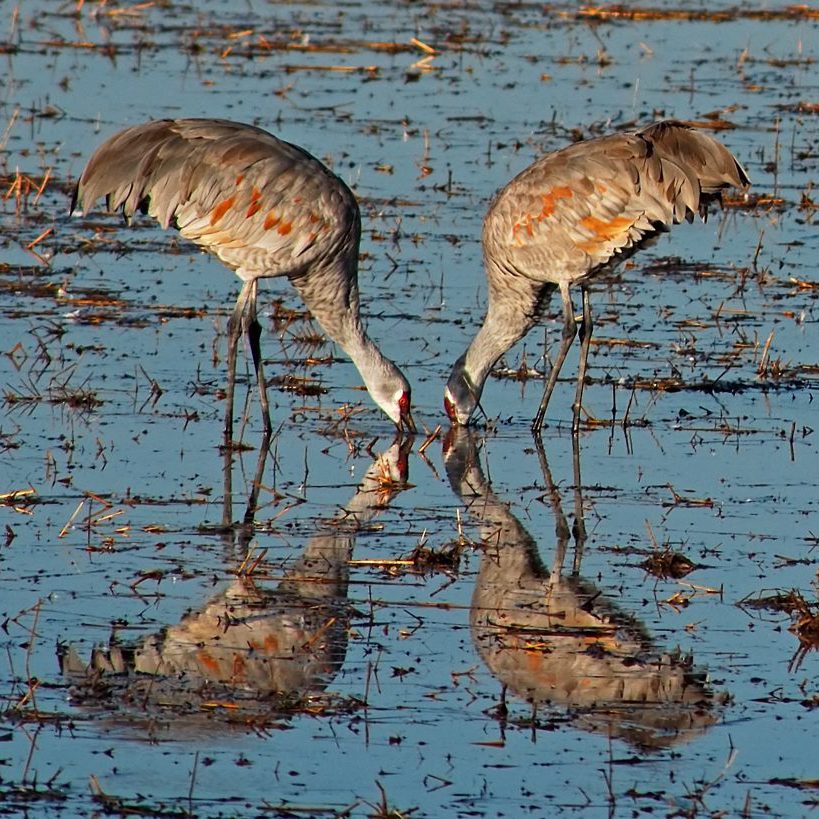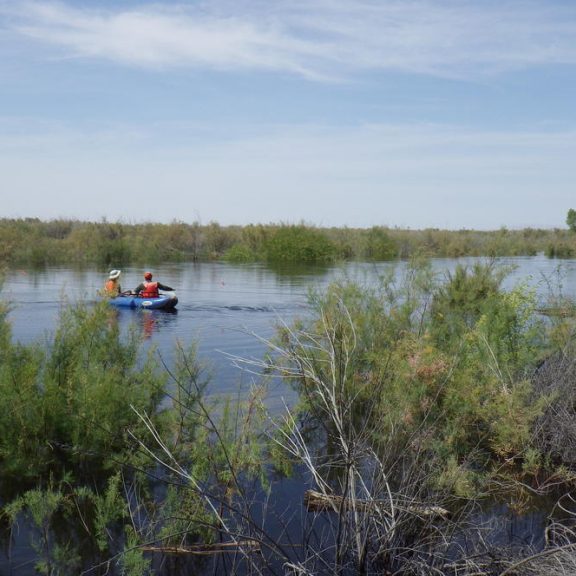
Click a link below for details.
Wetlands perform critical water quality, water quantity, and habitat functions in the landscape. In Colorado, surface water and groundwater feeding every municipal water system passes through wetlands, and more than 75% of wildlife species depend on wetlands for all or part of their life cycle.
Wetland Best Management Practices (BMPs) are actions that help protect wetlands and the functions they provide from temporary or permanent human disturbance. The optimal size and design of wetland buffers and other BMPs depends on factors like surrounding land use, vegetation, topography, hydrology, and habitat requirements for wetland-associated species.
Questions to consider when planning for and designing wetland BMPs:
- How is the wetland impacted by existing disturbance, and/or how will the wetland be impacted by a proposed disturbance?
- Can the disturbance be avoided or minimized?
- What are the objectives for the BMP, in terms of protecting the wetland? Examples include preserving/improving water quality within the wetland, limiting invasion of non-native species, and protecting wildlife habitat.
- What is the landscape position and hydrologic context of the wetland?
- What is the lifespan of the BMP (permanent or short-term)?
- How will the BMP(s) be operated and maintained to ensure that wetlands are protected for the duration of the disturbance?
We've provided a starting point for a variety of wetland BMPs, from buffers to wildlife. Please stay tuned for more BMPs in the future, or contact CNHP at the link at the bottom of this page if you know of new or existing BMPs for Colorado wetlands that we've missed.
Click a link below for details.

- The Environmental Law Institute's Planner's Guide to Wetland Buffers for Local Governments
- The City of Boulder's Wetland Protection Program Best Management Practices
- Update on Wetland Buffers: The State of the Science from the Washington Department of Ecology, provides a review of wetland buffers for preventing common pollutants like phosphorus and sediment from entering wetlands, as well as protecting wetland wildlife.


- For plant-specific guidance, the USDA Fact Sheets & Plant Guides page provides detailed information by species, including many BMPs related to grazing, fire, and other land management.
- The searchable USDA Fire Effects Information System also provides comprehensive plant information by species, including BMPs.
- Many Colorado wetlands host rare plants, and have unique needs for managing noxious weeds. The CO Department of Agriculture and CNHP have developed Recommended Best Management Practices for Managing Noxious Weeds on Sites with Rare Plants.
- Learn more about Colorado's state-listed Noxious Weeds here, including a variety of cultural, mechanical, chemical, and biological control options.
- Colorado Parks & Wildlife Species Profiles and Best Management Practices also provides information on managing a variety of noxious weeds in wildlife habitat.




Many resources exist for wildlife stewardship in managed landscapes. To get started, we’ve included a few state and regional resources to help you work and plan around wetland wildlife in Colorado. This section focuses on habitat protection, and the Aquatic Nuisance Species and Noxious Weeds section focuses on limiting the spread of invasive species and pathogens that can adversely impact native wildlife and their habitats.
- Colorado Parks & Wildlife maintains a growing list of fact sheets and habitat scorecards for priority wetland species, which provide management recommendations for species ranging from waterfowl to the Preble's meadow jumping mouse.
- The Waterfowl Management Handbook, originally published by the U.S. Fish and Wildlife Service, is one of the more comprehensive guidance documents available for waterfowl.
- For BMPs specific to birds and their associated wetland habitats, the Intermountain West Joint Venture (Western Slope, mountains, and intermountain valleys of Colorado) and Playa Lakes Joint Venture (the Great Plains) provide a variety of resources for land owners and managers.
- Beyond more commonly known wetland species like waterfowl, streams and wetlands support a variety of aquatic invertebrates that often provide critical water quality functions. The Xerces Society has BMPs for Protecting Native Western Freshwater Mussels During Aquatic and Riparian Restoration, Construction, and Land Management Projects and Activities.
- Wetland and riparian plants like milkweed also support terrestrial invertebrates like monarch butterflies. The Monarch Joint Venture has a guide to Mowing and Management: Best Practices for Monarchs to help avoid adverse impacts to monarch butterflies (and other insects) from mowing, burning, herbicide application, and other common management practices.
- Wetland habitats are often enticing to native (and non-native) wildlife. For temporary and permanent fencing for livestock exclosures, new plant protection from beavers and waterfowl, and other purposes, CPW has guidance on wildlife-friendly fencing, along with technical support and funding to help reduce conflicts between humans and wildlife.
- For wetland managers who want to encourage beaver activity, but reduce conflicts with culverts, roads, and other infrastructure, The Beaver Institute hosts information on road culvert protection, and other flow devices to help control pond water levels in developed areas.

Invasive organisms are a major threat to Colorado’s wetlands and waterbodies, causing once-common species like the boreal toad to be rare in our state, damaging reservoir intake structures, degrading wetland and upland ecosystems, and costing millions of dollars in control and cleanup. Many organisms can persist on boots, boats, and other items that travel between streams, lakes, ponds, and other wetlands--creating pathways for invasive species to become established in new areas.
- The USFWS Intermountain Region Guidance on Aquatic Invasive Species of Concern and Methods of Control includes BMPs for whirling disease, New Zealand mud snails, chytrid fungus, zebra/quagga mussels, didymo, and Eurasian watermilfoil.
- The Bsal Task Force maintains a list of disinfection procedures to help researchers, travelers, hikers, and others stop the spread of amphibian disease in aquatic environments, including chytrid and Bsal (affects salamanders).
- CPW also has guidance for preventing and controlling aquatic nuisance species in Colorado.
- The U.S. Department of the Interior has guidance on Safeguarding America's Lands and Waters from Invasive Species: A National Framework for Early Detection and Rapid Response.

Future increases in temperature, drought, and extreme weather events threaten all Coloradan livelihoods, as well as wetlands. Measures like reconnecting streams to their floodplains, restoring wet meadows and other headwater wetlands, and reintroducing beavers to streams that they historically occupied may help wetlands and streams be more resilient to climate change. Wetlands often provide refuge for wildlife, plants, and other organisms during wildfires, and habitat corridors for wildlife to migrate to suitable habitat. We will continue to update this section as new information is available.
- The Association of State Wetland Managers maintains a webpage dedicated to information on Wetlands and Climate Change, including information for water managers.
- The Playa Lakes Joint Venture has guidance for grazing around playas during drought.
- General information on Colorado's efforts to prepare and mitigate for climate change impacts across sectors, including water, agriculture, and ecosystems, can be found in the updated Colorado Climate Plan.
- Climate Change in Colorado: A Synthesis to Support Water Resources Management and Adaptation and the associated Climate Change in Colorado fact sheet also provides a review of the latest climate projections for our state.
- The United States Drought Monitor provides up-to-date national maps and other information for current drought conditions and future outlooks.
Colorado has a diverse array of wetland types, from playas to fens. Stay tuned for additional BMPs and information for more types of wetlands!
Click a link below for details.

- The USFS Technical Guide to Managing Groundwater Resources includes guidance for managing sensitive groundwater dependent ecosystems.

- The Utah State University Restoration Consortium has guidance and techniques for mimicking functions and initiating natural processes to restore streams and rivers in their Low-tech Process-based Restoration of Riverscapes Design Manual.
- The U.S. EPA's National Management Measures to Protect and Restore Wetlands and Riparian Areas for the Abatement of Nonpoint Source Pollution has guidance for specific to nonpoint, or diffuse sources of pollution such as fertilizers (nutrients) and pesticides.

- The Playa Lakes Joint Venture provides a variety of resources related to playa conservation and BMPs.
Click a link below for details.


- Forestry Best Management Practices to Protect Water Quality in Colorado from the Colorado State Forest Service (CSFS)
- National Best Management Practices for Water Quality Management on National Forest System Lands Volume 1: National Core BMP Technical Guide from the USDA Forest Service
- Forest Management to Protect Colorado's Water Resources from the Colorado Water Conservation Board and the CSFS
- The USDA Forest Service Rocky Mountain Research Station's Riparian fuel treatments in the western USA: Challenges and considerations technical report provides a review of potential effects of prescribed fire and fuels treatments on riparian areas in the West.
- USDA Forest Service's Forested Wetlands: Functions, Benefits, and the Use of Best Management Practices
- National Mangement Measures to Control Nonpoint Source Pollution from Forestry from the U.S. EPA, which includes BMPs for prescribed fire.
- The National Wildfire Coordinating Group's Guide to Preventing Aquatic Invasive Species Transport by Wildland Fire Operations
- The USFWS handbook on Fire Management and Invasive Plants
- Learn from the Burn: The High Park Fire 5 Years Later provides information on the efficacy of post-fire treatment activities in Northern Colorado

Historical and more recent mining activities have left a lasting and extensive legacy across much of Colorado. Many mountain floodplains were dredged for gold and other minerals, leaving tailings piles on what were once floodplain wetland and upland habitats. Some mountain wetlands are also influenced by acid mine and acid rock drainage, associated with the oxidation of iron sulfide. In the plains, and some intermountain valleys, gravel mining has altered floodplain soils and hydrology. During earthwork in mining areas, it is possible to encounter acid rock spoils and other materials that are toxic to aquatic ecosystems when mobilized. If you are working in any of these areas, it is important to have a containment plan in place for encountering hazardous materials. The International Network for Acid Prevention maintains a page for the Global Acid Rock Drainage Guide, which includes a section on prevention and mitigation. Other mining-related considerations include restoring healthy soil to promote plant growth.

- Colorado Parks & Wildlife Protect Colorado's Lands and Waters: Learn How You Can Stop Invasive Species for anglers, boaters, gardeners, pet owners, hunters, scuba divers, and other Coloradans recreating and working in wetlands or waterways.
- The National Trails Training Partnership has an extensive resource library for planning trails with wetlands, water quality, and wildlife in mind.
- The Rails-to-Trails Conservancy has guidance for developing trails in and around wetlands and other sensitive habitats.

- Federal Highway Administration Roadside Revegetation: An Integrated Approach to Establishing Native Plants and Pollinator Habitat and Ecoregional Revegetation Application (ERA)
- U.S. Army Corps of Engineers Construction Mat BMPs and Stream Crossing BMPs
- CDOT Erosion Control and Stormwater Quality Field Guide
- CDOT Temporary Erosion Control Standard Plans
- CDOT is using the augmented reality Sandbox Tool in its transportation erosion control supervisor training to educate supervisors on runoff generation and other watershed processes that influence water quality in wetlands and waterways.
- Urban Drainage and Flood Control District's Construction BMPs document
- The Resilient Crossings Landowner Handbook for Front Range rivers and streams

- The Urban Drainage and Flood Control District Criteria Manual has guidance for urban stormwater BMPs (including construction), and urban wetland revegetation, including detail drawings that can be used in construction plans, seed mixes and plant material recommendations for different site conditions, and maintenance considerations for urban areas.
- The Colorado Geological Survey report on Managing Stormwater to Protect Water Resources in Mountainous Regions of Colorado has BMP information relevant to Colorado mountain communities.
- The EPA's Protecting Natural Wetlands: A Guide to Stormwater Best Management Practices addresses urban water quality concerns specific to wetlands.
- The International Stormwater BMP Database has performance summaries for a variety of common urban BMPs, including different types of wetlands and many sites in Colorado.
- The Good Practices Handbook for Integrating Urban Development and Wetland Conservation outlines key steps and case studies for protecting, restoring, and creating wetland habitats in urban areas.
- For urban wetland managers working with mosquito issues, the Xerces Society has a guidance document for Ecologically Sound Mosquito Management in Wetlands.



- For evaluating the current condition of land relative to potential ecological states, plant lists, information on grazing to encourage high-quality native forage, and regional information on climate, hydrology, soil types, and plant communities associated with soils units mapped in your area, the NRCS Ecological Site Descriptions provide a wealth of information within your Major Land Resource Area.
- The BLM's Grazing Management Processes and Strategies for Riparian-Wetland Areas has specific guidance for grazing around riparian areas and other wetlands.
- Bird Conservancy of the Rockies has guidance related to grassland birds and other wildlife in Sharing Your Land with Northern Prairie Birds. While this document was developed for the northern Great Plains, many of the bird species and practices are relevant in the Colorado Great Plains.
- The Playa Lakes Joint Venture has a variety of playa conservation resources for landowners and agricultural producers.
- Hand-Built Structures for Restoring Degraded Meadows in Sagebrush Rangelands has examples and lessons learned from incised stream channel restoration in the Upper Gunnison River Basin.
- The USDA NRCS Stream Crossing guide includes information on creating durable stream crossings that protect aquatic and riparian habitat.
- For birds and other wildlife that may fall into stock water tanks, the NRCS has a Wildlife Escape Ladder Design for stock watering tanks to ensure that animals can safely escape.
- Bat Conservation International also has a Water for Wildlife guidance document on how to make stock tanks and other off-channel watering structures safe for bats and birds.




